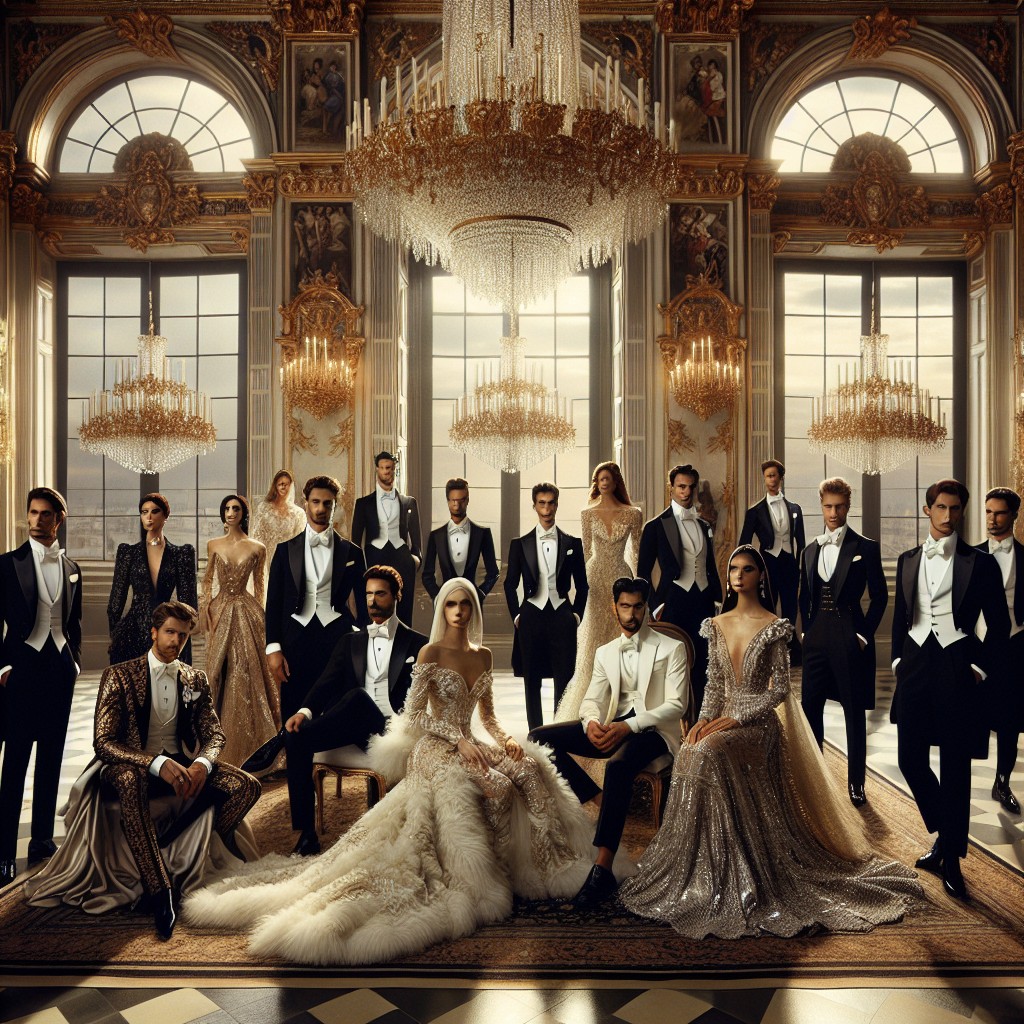Navigating wedding dress codes can be simple once you understand the common terms and expectations, which we’ll break down for you in this informational article.
Key takeaways:
- White-Tie: Men – tailcoat, bow tie, vest; Women – formal gowns, gloves.
- Black-Tie: Men – tuxedo, black bow tie; Women – evening gowns.
- Cocktail: Knee-length dresses for women, dark suits with a tie for men.
- Consider venue, time of day, season, comfort, and clarity.
- Do’s: include dress code on invitation, consider venue and time, offer examples, be prepared to answer questions.
- Don’ts: pick a restrictive dress code, assume guests know, ignore cultural sensitivities, leave dress code off invitation.
White-Tie

Associated with the pinnacle of formality and elegance, this dress code calls for the highest standard of dress for guests:
- Men should wear a black tailcoat, a white shirt with wing collars, a white bow tie, a white vest, and black patent leather shoes.
- Women are expected to dress in formal, floor-length evening gowns, preferably in subdued colors.
- Gloves can be a sophisticated addition for women, especially during the ceremony or a dance.
- Accessories should be kept to a minimum to maintain the sophistication of the attire; a well-chosen piece of jewelry can be a statement.
- Hair and makeup should be elegantly done, complementing the formality of the event.
White-tie is less common today but when chosen, it evokes a sense of grandeur and timeless tradition. It’s critical for invitations to clearly state this dress code to ensure all guests arrive appropriately attired.
Black-Tie
Traditionally reserved for evening events, a black-tie dress code calls for formal attire and is a step below white-tie in terms of formality. Men are expected to wear tuxedos with a black bow tie, while women should opt for elegant evening gowns or sophisticated cocktail dresses.
For a more modern twist, women can also consider tailored pantsuits. Fabrics should be luxurious, such as silk, satin, or velvet. It’s appropriate to add a dash of glamour with accessories like cufflinks for men and statement jewelry for women.
Shoes should be polished and refined – think patent leather for men and high-heeled sandals or pumps for women. A black-tie dress code communicates a sense of sophistication and ensures that guests look their best to match the grandeur of the event.
Cocktail
Striking a balance between formal and casual, a cocktail dress code invites guests to don elegant attire with a touch of playfulness. Women often wear knee-length dresses or sophisticated separates, while men typically opt for dark suits with a tie.
This less formal yet polished code encourages a range of expressive styles—think bold colors, unique accessories, and stylish shoes to create a festive yet refined atmosphere.
Classic cocktail attire provides room for personal flair, ensuring attendees feel comfortable and chic while celebrating.
How to Choose the Right Dress Code for Your Wedding
Selecting an appropriate dress code is a crucial component in setting the tone for your wedding. Consider the following points to ensure your chosen attire aligns well with the desired ambiance of your celebration:
1. Venue Atmosphere: Verify if your venue has a particular level of formality inherently associated with it. A castle or upscale ballroom may lend itself to a more formal dress code, such as black-tie, while a beach or garden might suggest a more casual approach.
2. Time of Day: Typically, evening events require more formal attire compared to daytime ceremonies. For an evening gala, consider a black-tie or formal dress code whereas a morning or afternoon event may be suitable for cocktail or casual dress.
3. Season: The season of your wedding can influence your dress code decision. For instance, summer months may call for lighter fabrics and more casual styles, while winter weddings might inspire more formal and warmer attires.
4. Comfort: Ensure your guests will feel comfortable with your dress code choice. If your wedding involves outdoor elements, such as a beach or barn setting, advising against stilettos or encouraging layers can be thoughtful.
5. Clarity: Make your dress code clear to your guests by providing examples or descriptions of preferred attire either on the invitation or through a wedding website. This removes guest guesswork and ensures everyone is on the same page.
6. Your Vision: Your own preference as a couple is paramount. Reflect on how you imagine your wedding; if a more laid-back or an ultra-sophisticated atmosphere is what you’re dreaming of, let your dress code mirror that vision.
Keep in mind these points to effectively guide you toward a harmonious dress code selection that contributes positively to the overall wedding experience.
Wedding Dress Code Dos and Don’ts
Understanding wedding dress code etiquette eases the stress on your guests and ensures your vision for the event is met. Here are some practical dos and don’ts:
Dos:
- Do include the dress code information clearly on the invitation.
- Do consider the venue and time of the event when determining the dress code – a beach wedding might suggest a more casual attire while an evening ballroom event leans towards a formal dress code.
- Do offer examples or insights when choosing less common dress codes — like “festive attire” — to give guests guidance on what is expected.
- Do expect that there may be questions and be prepared with a kind, concise response.
Don’ts:
- Don’t pick a dress code that is too restrictive or difficult for guests to achieve; comfort and accessibility are key.
- Don’t assume everyone knows the nuances of different dress codes — not all guests may be familiar with terms like “semi-formal” or “cocktail attire.”
- Don’t ignore cultural sensitivities and ensure your dress code is inclusive and considerate.
- Don’t leave the dress code off the invitation. Assuming guests will guess correctly can lead to discomfort and embarrassment.
Remember, the dress code you set can significantly impact the ambiance of your wedding, so choose thoughtfully and communicate it clearly.



